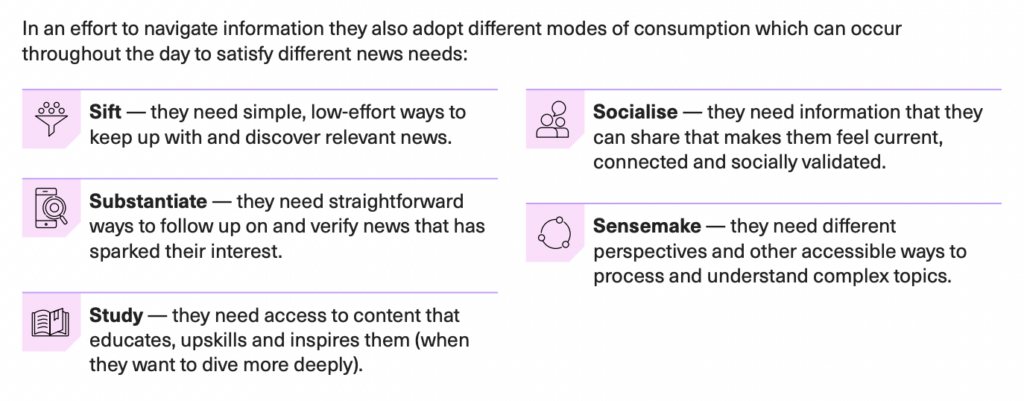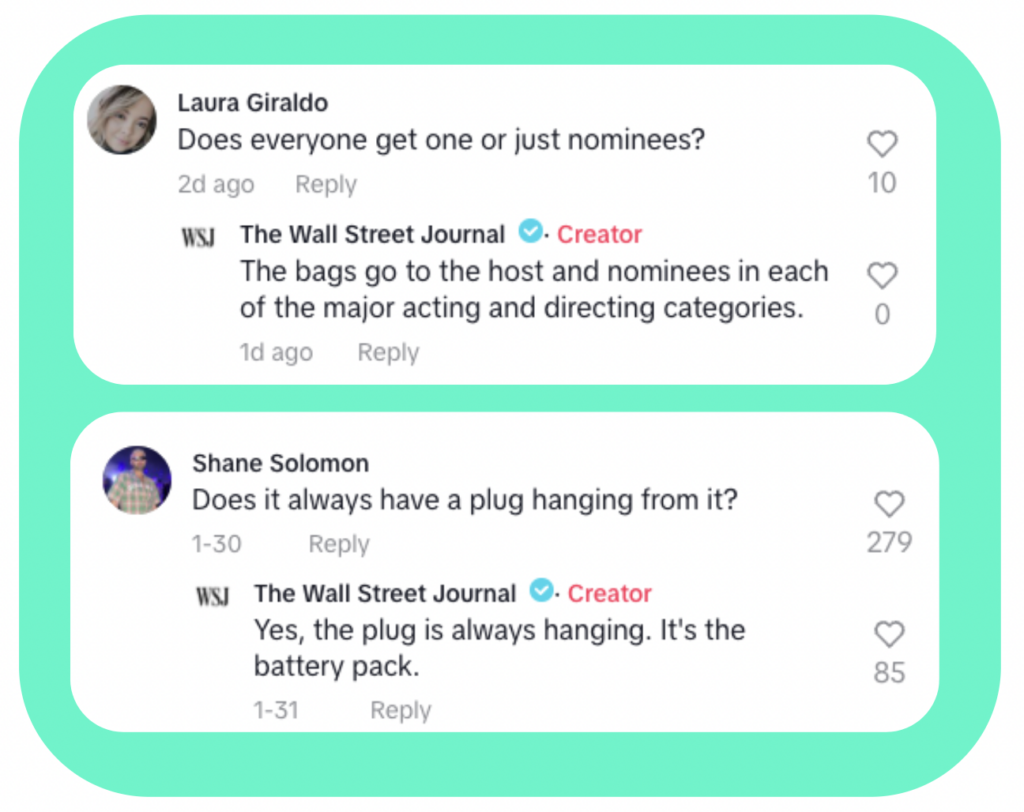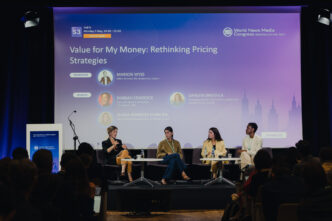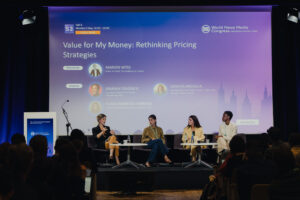

The Audiencers' Festival at The New York Times Building on March 15th brought together 150 digital publishing professionals to discuss everything from audience research to newsletters, engaging young audiences and maximizing on the value of registration.
Julia Munslow, Senior Platform Editor at The Wall Street Journal, spoke on stage about how she works on developing long term relationships with young audiences through TikTok. Joining the Journal from Yahoo! in 2021, Julia and her team spent a year thinking about how to launch on TikTok as a legacy news organization. The main goal: attract a new audience of younger readers.
The WSJ’s approach to attracting young audiences on TikTok
- A dedicated core team – including TikTok specialists and social media experts who do the majority of production work
- Collaborating with the newsroom – Julia’s team makes sure to train and coach journalists across the newsroom, making it as accessible as possible for everyone to be involved. Journalists are made aware of the social work that Julia’s team are doing, the places where they can step in and how to do this effectively (scripting, filming, hosting, fact checking, etc.).
- Smart curation – Julia’s team do the majority of the work, carefully considering hooks (the first 2-3 seconds of a video), visuals and topics. Their job is to carefully select and curate content for this specific audience, understanding that they’re not the same as traditional Journal readers. As research such as FT Strategies’ Next Gen News Report reveal, younger readers are seeking softer, less harsh news that’s accessible, helps them feel connected and doesn’t require much effort.

- Intentional tone – It’s not an easy job to engage these readers. Publishers are fighting for attention against not only other news sources but also influencers, celebrities and a user’s friends on these platforms. But understanding these audiences’ behavior, how they want to consume news whilst also taking lessons from “everyday people” Julia shared how they balance straightforward delivery with humorous skits.
Case Study #1: The power of compelling visuals
Why was this successful?
Aside from the traditional view metric, Julia also looks at other engagement metrics to get a more complete view of success.
- Over 20 million views
- High completion rate – 75% people finished this video (which is a very high percentage compared to benchmarks)
- Gained 34K followers just on this video alone
How did they make it a success?
- Bouncing off a big news moment
- Bespoke graphics + unique voiceover to make it more compelling
- Short video – young readers want to be told the key information in a short period of time, in an accessible and efficient way, to be able to learn something then scroll and get on with their day
Case Study #2: The power of exclusivity + SEO
Why was this successful?
- Longterm, consistent growth – in the 48hrs after publishing, this video gained 3M video views, which isn’t anything remarkable for the Journal. But a year later, it’s now at 9M views.
How did they make it a success?
- Newsroom evangelization – whenever you have a new platform, with new audiences, you have to let teams know what you’re doing, even simply via coffee chats, to get the word out and pick their brains and resources. This will pay off in the long term
- Planning – this story was an exclusive for the Journal, and they knew it was coming so could get ready for the moment of publication, making use of resources from across the newsroom
- Search optimization – including keywords, trending hashtags, and optimizing these over time. It’s thanks to this that the video’s performance has continued to grow over time, especially as younger audiences are turning to TikTok as a form of search engine
Case Study #3: The power of impact
Why was this successful?
- Expert POV – explainer video by an award winning journalist. Research has proven that young audiences care about who is telling the story, they often like it when someone has “been there” in the room (first-hand experience or is filming whilst there).
- Turned a complex subject into an engaging, accessible story – a viewer doesn’t need much context prior to the video to understand what’s going on.
- News peg to old award-winning coverage
How did they make it a success?
- Planning ahead of known news – this was also a story that they knew was coming so they had time to prepare, publishing it pretty much as soon as the news dropped
- Engaging visuals that were also reused across multiple platforms – this same video was published on Instagram and Snapchat
- Took action post-publication – engaging in the comment section. Young readers engage through conversation, so this continued interaction is important for trust and relationship building, which is an audience expectation on these platforms. This is why it’s valuable to have an expert in different platforms on your team, to understand the norms of each platform.
Case Study #4: The power of engagement
Why was this successful?
- WSJ angle on a big news moment, one that fits the Journal’s area of expertise but is also engaging for younger audiences with a unique point of view. Part of this is because of the algorithm, but also bringing value
- Over 1M views on TikTok
How did they make it a success?
- Planning ahead of known news moment
- On-camera host – makes the news feel more approachable and engaging, humanizing your brand, but also familiarity with some people appearing regularly, building a clear brand image
- Post-publication actions including engaging in the comments section
Strategies for engaging in the comments section
- Check the user and how to interact with them, make sure it’s not going to negatively impact your brand
- Use existing reporting OR talk to your reporters to help answer your questions

Why is this important?
- Young audiences consume news via discourse – this conversation takes time to develop, but you could start by posting a question to initiate the conversation. Or maybe try commenting on other videos that aren’t published by your brand. This humanizes your brand and makes you seem more accessible. You can also consider posting across platforms and encourage editors and reporters to share videos to start the conversation.
- Make videos complementary to a story – this opens up opportunities to develop the conversation, for embedding, for sharing, and you’re providing a new value that adds to your other work
The playbook
- Establish goals – why are you going on social? For WSJ on TikTok, it’s to help establish their brand identity, and figure out how to create a relationship with young audiences. Make sure these goals align with what’s possible on the platform (i.e. conversions via TikTok isn’t very feasible.
- Optimize for search – pay attention to what audiences are using for search, but it’s no longer just Google. And do this with all content
- Measure your impact – once you have your goals, measure whether you’re meeting them. One essential here is to establish benchmarks for each platform and content-type, to compare performance and see when a video has performed well. This way, you’re not only looking at videos that have high views as the sole success metric, but also median performance, and why it might have performed well in other areas, for other reasons. e.g. number of new followers, completion rate, audience demographic, etc.
- Take action post-publication – What can I do next to continue to expand the reach and performance of this content? Posting on other platforms, getting in the comment section, optimizing for SEO over time…
- Engage with a community – community is so important, but specific to each platform, so engage with users differently across platforms.
- Regularly update your strategy – once you have all of these things figured out, go back and do it again! Ensure you’re ahead of the game, keeping up with latest platform trends, testing and iterating with your strategy. Don’t be afraid to take risks! You never know when they may pay off.
Question from the audience: are there any insights here that can be applied on-site?
“I really encourage everyone to look at the North Western and FT report, it contains a lot of interesting insights on this topic. But one thing I like to say a lot is that you need to take these news consumers seriously – they may have a different profile, have different ways of consuming news, they might prefer social… but how can you integrate all of these learnings on-site? This could mean changing the tone of your reporting, experimenting with first-person point of view, adding more imagery or integrating social videos into content, but the important thing is to understand these audiences and apply learnings from social on-site.
Question from the audience: how does this tie back to the newsroom and how do you get buy in for this work when it’s not linked to traditional success metrics like page views?
“At the beginning, when you’re asking people to be on camera for social video for a new platform, some of them are going to look at you like you have 2 heads. But what we did was that we did a lot of preparation work before we started approaching people, and then we found it to be a snowball effect.
Once we looked at the platform, we took all the research we could find across the internet (about young readers, social, where people are getting their news, etc) to prove that this is where our potential audience is – we want those audiences, we should be there.
Then building the relationships around the newsroom, getting teams involved in the fun of social too. Evangelizing the newsroom, getting even the longer standing journalists to join a video. Finding your champions. But it’s not going to be everyone, and that’s ok, just push with those who are onboard.
And proving that it’s not a whole load more work for them. Our team will do all the hard work and will only ask for 15 minutes of a journalist’s time.
But to be honest, I don’t think there’s much convincing now for Tiktok. But when I was at Yahoo, people took a lot more convincing. So what we did was find the champions, the success stories, and really push those to prove the value of this platform and the time spent on it.”












